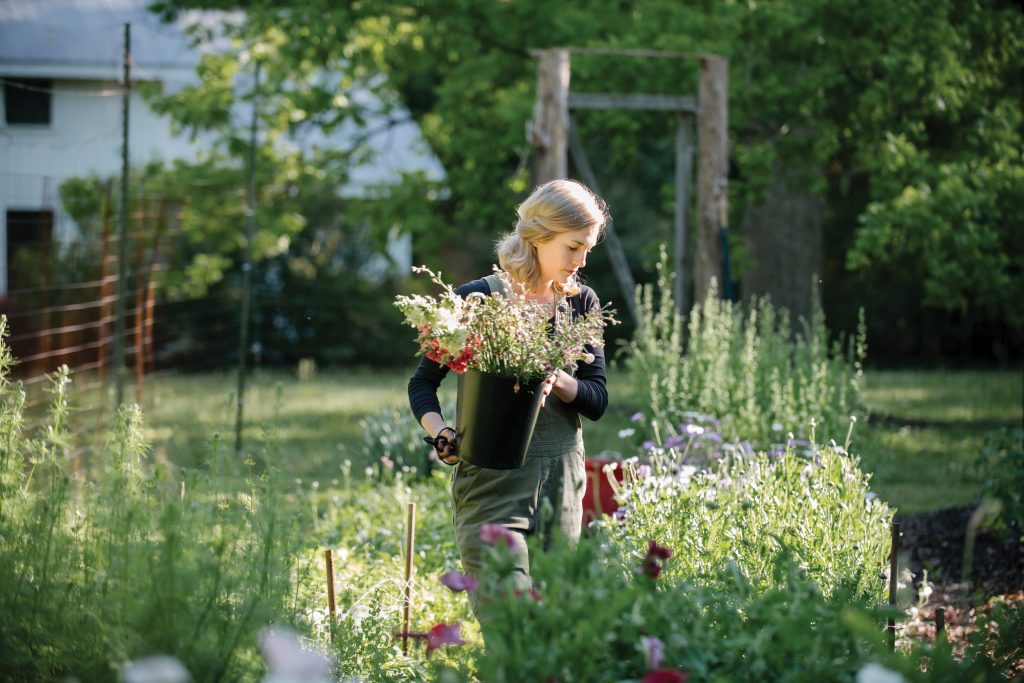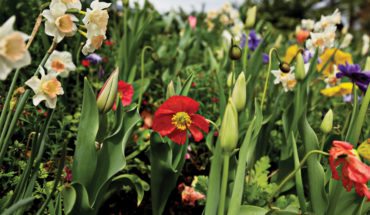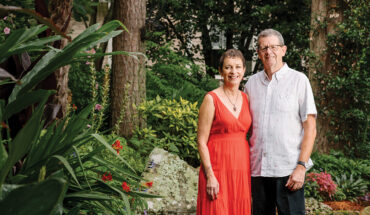Early spring is the time to flex your garden muscles as you plan for summer, plant annuals, and shore up your supplies.
by Hannah Ross

It’s the moment we’ve been waiting for patiently (or maybe a bit grumpily) all winter long. With the last frost date just around the corner on April 15, it’s finally ”go time” for gardeners. I’ve had seed packets in hand since January that warn, wait until all danger of frost has passed, and plant sales are popping up on every corner. Farmers markets suddenly feel like paradise, studded with the first ripe berries, tender spears of asparagus, ruffled lettuces, and a horde of hanging baskets vying for pride of place on our porches.
April is a feast for the senses, and if you plan, shop, and plant thoughtfully now, you’ll savor the rewards even as spring melts into summer. Here’s what to do in your garden in Raleigh in the month of April.
Mind the Weather
While the official last frost for our zone (7b) is on April 15, don’t blindly follow that date. Last year in Raleigh, our nighttime low on April 16 was 37 degrees — not a frost here in the city, but too cold for tender annuals to take unscathed — and I remember hustling to cover up tomatoes and zinnias I’d planted early. While everything fared just fine as temperatures didn’t reach the forecasted low, it was enough of a threat to make this gardener sweat.
While avoiding frost is critical, even temperatures above freezing can damage many tender plants; heat-loving summer annuals prefer nighttime temperatures in the mid 50s and above. Planting early can feel like getting ahead, but sometimes waiting until late April (or even early May) for warmer nighttime temperatures can mean happier plants and higher productivity in the long run, especially for true heat-lovers like tropicals, peppers, and tomatoes. So keep an eye on the long term forecast: if in early April temperatures are safely near 50 and above at night stretching two weeks out, go ahead and plant. Just keep a frost cover at the ready until mid-April, in case a surprise cold front sweeps in.
Make a Plan
As mid-April nears, garden centers and plant sales transform with a riot of color and fragrance. It’s easy to impulse shop, forgetting constraints like budget, available planting space, sun exposure, container sizes, and the like. So before you go overboard with your plant shopping (I know from experience), make a plan to help guide your choices. Ask yourself questions and make notes like:
What did I grow and love last year that I’d enjoy planting again?
What didn’t work well last year, that I’ve learned isn’t worth the space or the fuss?
Which supplies do I have on hand, and which do I need to replenish?
How many containers and of what sizes do I have to fill?
What are the dimensions of my raised beds, and how many veggies can I fit in each?
What colors am I drawn to in this season of my life?
With these questions in mind, make whatever kind of list or drawing is most helpful to you. Maybe it’s a wish list of plant varieties, or maybe it’s a sketch of your garden beds on graph paper (including dimensions), which can help you determine how many plants you need to fill the space.
I enjoy shopping for plants the way Alice Waters encourages us to shop for produce: letting what looks healthy and lush speak to us and inform our creative choices. But having a plan helps create boundaries around this intuitive exploration, to make sure I can give a happy home to each plant I purchase and ensure I don’t obliterate my budget. Doing an audit of supplies you already have versus supplies that you need is another helpful practice; I can’t tell you how many times I’ve bought duplicate supplies at the garden center because I forgot to check my shed first.
Shop Locally
Opportunities abound for local plant shopping From independently owned garden centers, to world-renowned botanical gardens, to bountiful farmers’ markets and amazing annual plant sales, the Triangle is an inspiring place to garden.
Check out this roundup of spring plant sales around the Triangle. Local plant sales feature a variety of specialities and often offer unique varieties for home gardeners, including vegetables, trees, shrubs, herbs, cut flowers, and native perennials. These sales are also wise places to look for organically grown seedlings, which are often unavailable at larger nurseries.
Many local plant sales benefit inspiring causes and organizations, such as high school Future Farmers of America (FFA) chapters. FFA provides opportunities for students to learn leadership skills while growing food, caring for animals, and learning to identify plants. Check your neighborhood high schools to see if they have an FFA or other benefit plant sale. My gardening obsession traces back to my own FFA experience at Wakefield High School (definitely check out their sale), and I love the idea that shopping public school sales can help nurture emerging green thumbs and nature lovers.
In addition to hopping from plant sale to plant sale, April is a fantastic time to explore nurseries we don’t typically frequent. Some of my favorites include: Big Bloomers Flower Farm in Sanford, Campbell Road Nursery on the west side of Raleigh, Logan’s Garden Shop in downtown Raleigh, Homewood Nursery in North Raleigh, Durham Garden Center, Country Farm & Home in Pittsboro, Garden Supply Company in Cary, and Piedmont Feed & Garden Center in Chapel Hill. Between these nurseries, your local farmers’ market, and the aforementioned plant sale roundup, there’s surely no botanical specimen you can’t track down in the Triangle.
Succession-Sow Spring Crops
While our focus tends to shift to summer annuals this month, we can enjoy a lingering spring by continuing to direct sow quick-growing, cool weather crops in the garden. Known as succession sowing, the method of replanting a crop every couple weeks helps to extend its harvest season, and keeps us enjoying a variety of homegrown foods.
While slow-growing spring crops like cauliflower or cabbage won’t mature well with April planting, veggies and herbs that mature in 4-6 weeks and tolerate a bit of heat are still fair game, including lettuce, Asian greens, dill, kale, collards, arugula, Hakurei turnips, and radishes. For leafy green vegetables like leaf lettuce and kale, sow seeds thickly to enjoy cut-and-come-again baby greens.
Once temperatures heat up, you’ll notice cool weather crops starting to “bolt” — that is, sending up flowering stalks before fully mature. At this point, the flavor typically becomes more bitter and stems toughen. You can avoid bolting by planting more heat-tolerant varieties of spring crops and offering these vegetables a bit of afternoon shade. The bright side of bolting? Pollinators love the blooms, so leave them be until you need the space for something else.
Plant Tender Annuals
As nighttime temperatures warm consistently into the 50s, you can plant tender annuals. These are vegetable, herb, and flower plants that cannot tolerate a frost, and that thrive in warm conditions (as opposed to hardy annuals, which take frosts in stride and grow best in cool temperatures). Tender annual vegetables include tomatoes, peppers, eggplant, cucumbers, melons, winter and summer squash, zucchini, sweet potatoes, corn, and beans. While you’re planting tender vegetables, don’t forget heat-loving companion plants. Companions serve various functions, from attracting beneficial insects, to repelling pests, to enhancing vegetable flavor. Effortless companion plants include marigolds, basil, borage, and nasturtium.
If you want ornamental plants for a patio, or flowers for a cutting garden, there are lots of options for brightening your outdoor spaces. Once the last frost is behind us, it’s safe to plant flowering annuals like petunia, geranium, begonia, marigold, zinnia, cosmos, celosia, gomphrena, ageratum, verbena, cleome, and sunflower. If you have vertical space, explore annual flowering climbers like black-eyed Susan vine, hyacinth bean, or love-in-a-puff.
Get Friendly with the Mulch Pile
Mulching is one of the best tools for creating a low-maintenance, more ecologically sustainable, thriving summer garden. A generous layer of mulch not only suppresses weeds, but protects roots from harsh elements, retains soil moisture, and supports an active microbial community underneath the surface. Leaf mold is my mulch of choice, and it can be affordably purchased from the City of Raleigh Yard Waste Center. Bark and straw mulch work, too — but leaf mold does wonders for building a beautiful, crumbly, coffee-black soil over the seasons. Applying mulch now while temperatures are cool is both better for the soil (mulch can trap heat if applied during hot weather) and better for the gardener. Who wants to sling mulch when it’s 100 degrees outside? Do the dirty work now, when the weather is so glorious that we could happily do just about anything outside (nevermind the lemon haze of pollen).
______
This story was originally published in March 2022 on waltermagazine.com




Pingback: 20+ Things do in April in and Around Raleigh - WALTER Magazine